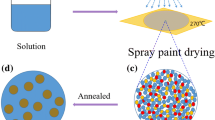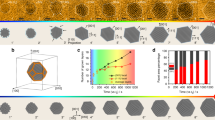Abstract
Fivefold symmetry appears only in small particles and quasicrystals because internal stress in the particles increases with the particle size. However, a typical Marks decahedron with five re-entrant grooves located at the ends of the twin boundaries can further reduce the strain energy. During hydrothermal synthesis, it is difficult to stir the reaction solution contained in a digestion high-pressure tank because of the relatively small size and high-temperature and high-pressure sealed environment. In this work, we optimized a hydrothermal reaction system by replacing the conventional drying oven with a homogeneous reactor to shift the original static reaction solution into a full mixing state. Large Marks-decahedral Pd nanoparticles (~90 nm) have been successfully synthesized in the optimized hydrothermal synthesis system. Additionally, in the products, round Marks-decahedral Pd particles were also found for the first time. While it remains a challenge to understand the growth mechanism of the fivefold twinned structure, we proposed a plausible growth-mediated mechanism for Marks-decahedral Pd nanoparticles based on observations of the synthesis process.

This is a stepwise growth mechanism for Marks-decahedral Pd nanoparticles. First, many truncated tetrahedrons are formed. Then, two adjacent {111} facets of a truncated single tetrahedron simultaneously grow epitaxially, forming a truncated tri-tetrahedron. A Marks decahedron is formed directly by epitaxial growth of both concave {111} facets of a truncated tri-tetrahedron.






Similar content being viewed by others
References
Choi S-I, Herron JA, Scaranto J, Huang H, Wang Y, Xia X, Lv T, Park J, Peng H-C, Mavrikakis M, Xia Y (2015) A comprehensive study of formic acid oxidation on palladium nanocrystals with different types of facets and twin defects. ChemCatChem 7(14):2077–2084
De Wit R (1972) Partial disclinations. J Phys C 5(5):529
Elechiguerra JL, Reyes-Gasga J, Yacaman MJ (2006) The role of twinning in shape evolution of anisotropic noble metal nanostructures. J Mater Chem 16(40):3906–3919
Gao Y, Jiang P, Song L, Wang JX, Liu LF, Liu DF, Xiang YJ, Zhang ZX, Zhao XW, Dou XY, Luo SD, Zhou WY, Xie SS (2006) Studies on silver nanodecahedrons synthesized by PVP-assisted N,N-dimethylformamide (DMF) reduction. J Cryst Growth 289(1):376–380
Gilroy KD, Ruditskiy A, Peng HC, Qin D, Xia Y (2016) Bimetallic nanocrystals: syntheses, properties, and applications. Chem Rev 116(18):10414–10472
Huang HW, Wang Y, Ruditskiy A, Peng HC, Zhao X, Zhang L, Liu JY, Ye ZZ, Xia YN (2014) Polyol syntheses of palladium decahedra and icosahedra as pure samples by maneuvering the reaction kinetics with additives. ACS Nano 8(7):7041–7050
Ji W, Qi W, Tang S, Huang B, Wang M, Li Y, Jia Y, Pang Y (2014) Synthesis of Marks-decahedral Pd nanoparticles in aqueous solutions. Part Part Syst Charact 31(8):851–856
Ji W, Qi W, Li X, Zhao S, Tang S, Peng H, Li S (2015) Investigation of disclinations in Marks decahedral Pd nanoparticles by aberration-corrected HRTEM. Mater Lett 152:283–286
Jin MS, Zhang H, Xie ZX, Xia YN (2012) Palladium nanocrystals enclosed by {100} and {111} facets in controlled proportions and their catalytic activities for formic acid oxidation. Energy Environ Sci 5(4):6352–6357
Johnson CL, Snoeck E, Ezcurdia M, Rodriguez-Gonzalez B, Pastoriza-Santos I, Liz-Marzan LM, Hytch MJ (2008) Effects of elastic anisotropy on strain distributions in decahedral gold nanoparticles. Nat Mater 7(2):120–124
Li Y, El-Sayed MA (2001) Suzuki cross-coupling reactions catalyzed by palladium nanoparticles in aqueous solution. Abstr Pap Am Chem Soc 222:U335–U335
Lim B, Wang J, Camargo PH, Cobley CM, Kim MJ, Xia Y (2009) Twin-induced growth of palladium-platinum alloy nanocrystals. Angew Chem Int Edi 48(34):6304–6308
Liu Y, Chi M, Mazumder V, More KL, Soled S, Henao JD, Sun S (2011) Composition-controlled synthesis of bimetallic PdPt nanoparticles and their electro-oxidation of methanol. Chem Mater 23(18):4199–4203
Lofton C, Sigmund W (2005) Mechanisms controlling crystal habits of gold and silver colloids. Adv Funct Mater 15(7):1197–1208
Marcus RA (1993) Electron transfer reactions in chemistry. Theory and experiment. Rev Mod Phys 65(3):599–610
Marks LD (1983) Modified Wulff constructions for twinned particles. J Cryst Growth 61(3):556–566
Marks LD (1984) Surface structure and energetics of multiply twinned particles. Philos Mag A 49(1):81–93
Marks LD, Smith DJ (1981) High resolution studies of small particles of gold and silver. J Cryst Growth 54(3):425–432
Qi W (2016) Nanoscopic thermodynamics. Accounts Chem Res 49(9):1587–1595
Ringe E, Van Duyne RP, Marks LD (2013) Kinetic and thermodynamic modified Wulff constructions for twinned nanoparticles. J Phys Chem C 117(31):15859–15870
Shao MH, Yu T, Odell JH, Jin MS, Xia YN (2011) Structural dependence of oxygen reduction reaction on palladium nanocrystals. Chem Commun 47(23):6566–6568
Shechtman D, Blech I, Gratias D, Cahn JW (1984) Metallic phase with long-range orientational order and no translational symmetry. Phys Rev Lett 53(20):1951–1953
Smith DJ, Marks LD (1981) High resolution studies of small particles of gold and silver. J Cryst Growth 54(3):433–438
Tsuji M, Ogino M, Matsuo R, Kumagae H, Hikino S, Kim T, Yoon S-H (2010) Stepwise growth of decahedral and icosahedral silver nanocrystals in DMF. Cryst Growth Des 10(1):296–301
Washio I, Xiong Y, Yin Y, Xia Y (2006) Reduction by the end groups of poly(vinyl pyrrolidone): a new and versatile route to the kinetically controlled synthesis of ag triangular nanoplates. Adv Mater 18(13):1745–1749
Xia X, Xie S, Liu M, Peng H-C, Lu N, Wang J, Kim MJ, Xia Y (2013) On the role of surface diffusion in determining the shape or morphology of noble-metal nanocrystals. P Natl A Sci USA 110(17):6669–6673
Xia Y, Xia X, Peng HC (2015) Shape-controlled synthesis of colloidal metal nanocrystals: thermodynamic versus kinetic products. J Am Chem Soc 137(25):7947–7966
Yacaman MJ, Ascencio JA, Liu HB, Gardea-Torresdey J (2001) Structure shape and stability of nanometric sized particles. J Vac Sci Technol B 19(4):1091–1103
Yacamán MJ, Ascencio JA, Liu HB, Gardea-Torresdey J (2001) Structure shape and stability of nanometric sized particles. J Vac Sci Technol B 19(4):1091
Zhang J-M, Ma F, Xu K-W (2004) Calculation of the surface energy of FCC metals with modified embedded-atom method. Appl Surf Sci 229(1–4):34–42
Zhang H, Jin MS, Xiong YJ, Lim B, Xia YN (2013) Shape-controlled synthesis of Pd nanocrystals and their catalytic applications. Accounts Chem Res 46(8):1783–1794
Zheng H, Alivisatos AP (2009) Observation of single colloidal platinum nanocrystal growth trajectories. Science 324(5932):1309–1312
Acknowledgments
This study was funded by the National Nature Science Foundation of China (grant number 21373273).
Author information
Authors and Affiliations
Corresponding author
Ethics declarations
Conflict of interest
The authors declare that they have no conflict of interest.
Electronic supplementary material
ESM 1
(AVI 104109 kb)
Rights and permissions
About this article
Cite this article
Zhao, H., Qi, W., Ji, W. et al. Large Marks-decahedral Pd nanoparticles synthesized by a modified hydrothermal method using a homogeneous reactor. J Nanopart Res 19, 162 (2017). https://doi.org/10.1007/s11051-017-3856-0
Received:
Accepted:
Published:
DOI: https://doi.org/10.1007/s11051-017-3856-0




